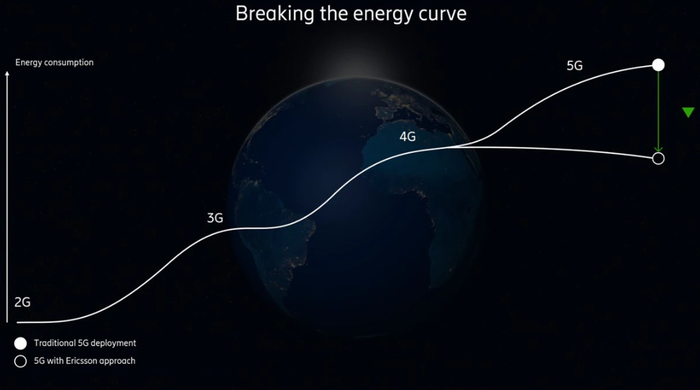Ericsson highlights the telco industry's green problemEricsson highlights the telco industry's green problem
Ericsson has unveiled a new report to promote itself with a green twist, but also highlighting the potential damage new 5G networks could have on the environment.
March 12, 2020

Ericsson has unveiled a new report to promote itself with a green twist, but also highlighting the potential damage new 5G networks could have on the environment.
Like many self-serving politicians, Ericsson is using the green agenda to further it own credibility in the RAN segment, though it has stumbled across what is becoming a very serious issue which has been paid little attention to date. As more telcos integrate sustainability and green elements into the corporate strategies, new networks will be energy guzzlers the likes of which the industry has never seen.
It should not come as a surprise, as you can see from the diagram lifting from Ericsson’s ‘Breaking the Energy Curve’ report.

“The answer is yes,” Ericsson CTO Erik Ekudden writes in the report. “It is possible to break the energy curve, i.e. lowering total mobile network energy consumption from today’s level and meeting the massive traffic growth challenge.
“It is not just a possibility. In fact, we believe it is our responsibility, together with all other ICT industry players. Ericsson estimates the current yearly global energy cost of running mobile networks to be $25 billion. From both cost and carbon footprint perspectives, energy consumption is one of our industry’s biggest challenges.”
The impact of these networks on the environment is already quite apparent but will only become more severe unless more energy efficient solutions are sourced. Not only does higher spectrum usually mean more power, networks are set to become denser in the urban environments and more widespread through the rural ones.
Society’s appetite for data is only increasing, therefore networks will become more powerful and ubiquitous. This is demonstrated in the table below, a measure of the carbon emissions from O2 in the UK.
Carbon emissions
Year | tCO2eq |
2012 | 6,696.68 |
2013 | 8,432.71 |
2014 | 7,448.12 |
2015 | 10,840.78 |
2016 | 10,269.38 |
2017 | 7,699.95 |
2018 | 7,159.89 |
The numbers have been decreasing, partly thanks to more energy efficient solutions and clean technology, though the company will have also been offsetting its carbon footprint through various different schemes. Although it is better than nothing, these initiatives should not be seen as the answer as they simply cover up the damage which is being inflicted. Theoretically, burning down a family home and building one elsewhere offsets the consequence, but does it make up for the original act?
It might be a bit unfair to point the finger at O2 here. Every telco will most likely be the same, while progress is being made. The UK telco recently said it has plans to be carbon neutral by 2025 and has also been writing certain sustainability objectives into contracts with its suppliers.
Like O2, a raft of other telcos have been integrating climate change objectives into the corporate strategy. It is a top down effort which should herald results. Orange is another which has set itself a sustainability challenge, the Engage 2025 Strategy outlines an ambition to be carbon neutral by 2040, while BT said it would like to be carbon neutral by 2045 in its 2019 Sustainability report. The GSMA has pledged to get the industry carbon neutral by 2050.
While it might be easy to dismiss something of these statements as PR posturing, there are technologies emerging to aid such missions.
Ericsson offers multi-standard hardware platforms which can help reduce the physical footprint of a network, while it also offers spectrum sharing services to allow telcos to run 4G and 5G simultaneously on the same spectrum. Deploying the latest radio technologies can offer as much as a 30% reduction on energy consumption, a significant figure when you speak to the telco CTOs about how big their energy bills are.
Of course what is worth bearing in mind is that these networks are becoming increasingly dominated by software not hardware. There are new solutions which can dynamically shift performance of products to aid energy consumption. For example, Ericsson is boating of ‘RAN sleep mode’ features to its network management software to help manage the network more effectively. Viavi is another company which is championing new approaches to managing a network through software.
Paul Gowans, Global Director of Solutions Marketing at Viavi, highlighted to use the team had developed a geo-optimised machine learning based algorithm which scales-up and scales-down the performance of the network depending on demand. For example, the networks powering towns in a city’s commuter belt can be optimised between 9am and 5pm. Certain sites can be powered down as demand decreases during the working hours.
Building and managing networks more effectively will of course be a consideration for every telco, both from a commercial and CSR perspective, but what remains to be seen is whether these initiatives and technologies compensate for the increased impact of future networks. Being carbon neutral is all well and good, but if too much of this objective is attributable to projects to offset the initial impact, does it not undermine the ambition of being more environmentally conscious?
About the Author
You May Also Like










.png?width=300&auto=webp&quality=80&disable=upscale)


_1.jpg?width=300&auto=webp&quality=80&disable=upscale)